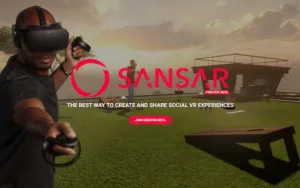Linden Lab, the San Francisco based VR development company that introduced us to Second Life and Blocksworld has opened the Sansar Creator beta to developers. Sansar is a development platform that allows developers to create their own VR world and share this with other users. Currently the number of users in one VR world at a time is limited to 35, a number Linden Lab wants to increase to 100 in coming months.
Linden Lab announces Sansar a VR development platform
Sansar allows the developers to create VR experiences without writing code, even though this is also possible. There are many tools available to create experiences without writing code. In addition, developers can write code and sell their development efforts in the related store. In summary, Sansar is a platform to quickly create VR content and turn your creation into a hosted, multi-user experience for PC, Oculus Rift, and HTC Vive users. The platform will allow developers to charge users in a platform currency called Sansar dollars or even sell their experience altogether.
While there is very little information on the website, Linden Lab has also created You Tube videos to explain a little better what Sansar is supposed to be. There is also a more details available in Charlie Fink’s article “Sansar Ignites VR Content Boom” published by Forbes.
Analyst Comment
This is a very interesting approach to overcome the VR content hurdle and allow developers to create VR experiences that they can use to create a business by charging users. The really neat part of this development is the fact that the developers are not necessarily app developers in the common sense, but more or less artistic people that know how to create a visually pleasing environment without the need to write computer code. This makes VR content development a one person activity rather than a large group effort. If you like, this is similar to the introduction of apps rather than software. More developers will be able to create more experiences than larger groups in a smaller amount of time for less money. In the end we should have more content at lower cost and that is a great start for developing VR for the masses. The only drawback is the limited number of users that can be in the experience at one time. (NH)

